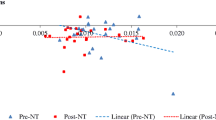Abstract
This paper uses minute by minute data series from Chinese commodity futures markets to study patterns of intraday effect and discovers the L pattern of absolute return and volume. It is different from stock market, which has a distinctive pattern of U-shaped. The financial market microstructure theory, traders’ psychology and trading mechanism are applied to explain it. Then this paper studies the factors that influence volatility of return and the lagged orders. The results show that there is a bilateral Granger causality among any two of the absolute return, volume and open interest, and it is different from the empirical results of the stock market, in the sense that there is only a unilateral Granger causal relationship from volume to absolute return. The authors also analyze the dynamic relationship among these three factors. The empirical results tell that the influence of open interest on volatility of absolute return and volume is weak, and there is a strong correlation between absolute return and volume. Some investment suggestions are offered from the analysis mentioned above.
Similar content being viewed by others
References
Admati A and Peleiderer P, A theory of intradaily patterns: Value and price variability, The Review of Financial Studies, 1988, 1(1): 3–40.
Brock W A and Kleidon A W, Periodic market closure and trading volume, Journal of Economic Dynamic and Control, 1992, 16(3): 451–489.
Andersen T and Bollerslev T, Intraday periodicity and volatility persistence in financial markets, Journal of Empirical Finance, 1997, 4(2): 115–158.
Andersen T, Bollerslev T, Diebold F, and Labys P, The distribution of realized exchange rate volatility, Journal of the American Statistical Association, 2001, 96(453): 42–55.
Hasbrouck J, Trading Fast and Slow: Security Market Events in Real Time, Stern School of Business, New York, 1999.
Ding D K and Lau S T, An analysis of transactions data for the stock exchange of Singapore: Pattern, absolute price change, change, trade size and number of transactions, Journal of Business Financial and Accounting, 2001, 28(1–2): 151–174.
Rahman S, Lee C F, and Aug K P, Intraday return volatility process: Evidence from Nasdaq stocks, Review of Quantitative Finance and Accounting, 2002, 19(2): 155–180.
Andersen T, Bollerslev T, and Cai J, Intraday and interday volatility in the Japanese stock market, Journal of International Markets, 2000, 10(2): 107–130.
Jain P C and Joh G H, The dependence between hourly prices and trading volume, Journal of Financial and Quantitative Analysis, 1988, 23(3): 269–283.
Mcinish T and Wood R, A transaction data analysis of the variability of common stock during 1980–1984, Journal of Banking and Finance, 1990, 14(1): 99–112.
Mcinish T and Wood R, Hourly returns, volume, trade size and number of trades, Journal of Finance, 1991, 14(4): 303–315.
Mcinish T and Wood R, An analysis of intradaily patterns in bid/ask spreads of NYSE stocks, Journal of Finance, 1992, 47(2): 753–764.
Liu L, Liu C X, Li W G, et al., The empirical study of the intraday characters of changes in the volume of transactions and prices of Shanghai and Shenzhen stock market, Economic Science, 2000, (1): 52–65.
Fang Z M and Wang C F, The study of the intraday characters of market returns of Shanghai stock market, Journal of Beijing Institute of Technology, 2004, (6): 38–41.
Qu W Z and Wu S N, The analysis of the characteristics of microstructure of China’s stock market, Economic Science, 2002, (1): 56–63.
Guo Y F and Wei Y, A study of calendar effect in the benchmark index of China’s stock index futures, Journal of Southwest Jiaotong University (Social Sciences), 2007, 5: 1–5.
Wei L Y and Ma Y K, Intra-day periodicity of fund market: A case study on high frequency data in Shenzhen, Contemporary Economy & Management, 2007, 1: 101–105.
Gong L, Calendar effects analysis of Chinese stock market based on behaviour finance, Shandong University, Jinan, 2011.
Copeland T E, A model of asset trading under the assumption of sequential information arrival, Journal of Finance, 1976, 31(4): 1149–1168.
Clark P K, A subordinated stochastic process model with finite variance for speculative prices, Econometrica, 1973, 41(1): 135–155.
Tauchen G E and Pitts M, The price variability volume relationship on speculative markets, Econometrica, 1983, 51(2): 485–505.
Westerfield R, The distribution of common stock prices changes: An application of transactions time and subordinated stochastic models, Journal of Financial and Quantitative Analysis, 1977, 12(5): 743–765.
McCarthy J and Najand M, State space modelling of price and volume dependence: Evidence from currency futures, The Journal of Futures Markets, 1993, 13(4): 335–344.
Hua R H and Zhong W J, The dynamic analysis of China’s futures market futures price gains, trading volume, correlation of volatility, Statistical Research, 2003, (7): 23–30.
He X Q, The dynamic causal relationship between stock returns and trading volume: China’s evidence, South China Journal of Economics, 2006, 6: 102–110.
Liang L Z, The return-volume relations in Chinese stock market by quantile regression, Statistical Research, 2008, 12: 73–78.
Li P and Ren Y, Analysis of quantile regression about the relationship between price and volume of China stock markets, Journal of Applied Statistics and Management, 2011, 6: 1097–1103.
Amihud Y and Mendelson H, Asset pricing and the bid-ask spread, Journal of Financial Economics, 1986, 17(2): 223–249.
Easley D and O’Hara M, Time and the process of security price adjustment, Journal of Finance, 1992, 47(2): 577–605.
Author information
Authors and Affiliations
Corresponding author
Additional information
This research was supported by the National Science Fund of China under Grant Nos. 71471182 and 71071170, Program for New Century Excellent Talents in University under Grant No. NCET-11-0750 and Program for Innovation Research in Central University of Finance and Economics.
This paper was recommended for publication by Editor YANG Cuihong.
Rights and permissions
About this article
Cite this article
Liu, X., Wang, S. Study on the intraday pattern and the dynamic correlation among return, volume and open interest — evidence from Chinese commodity futures markets. J Syst Sci Complex 28, 156–174 (2015). https://doi.org/10.1007/s11424-015-2059-y
Received:
Revised:
Published:
Issue Date:
DOI: https://doi.org/10.1007/s11424-015-2059-y




